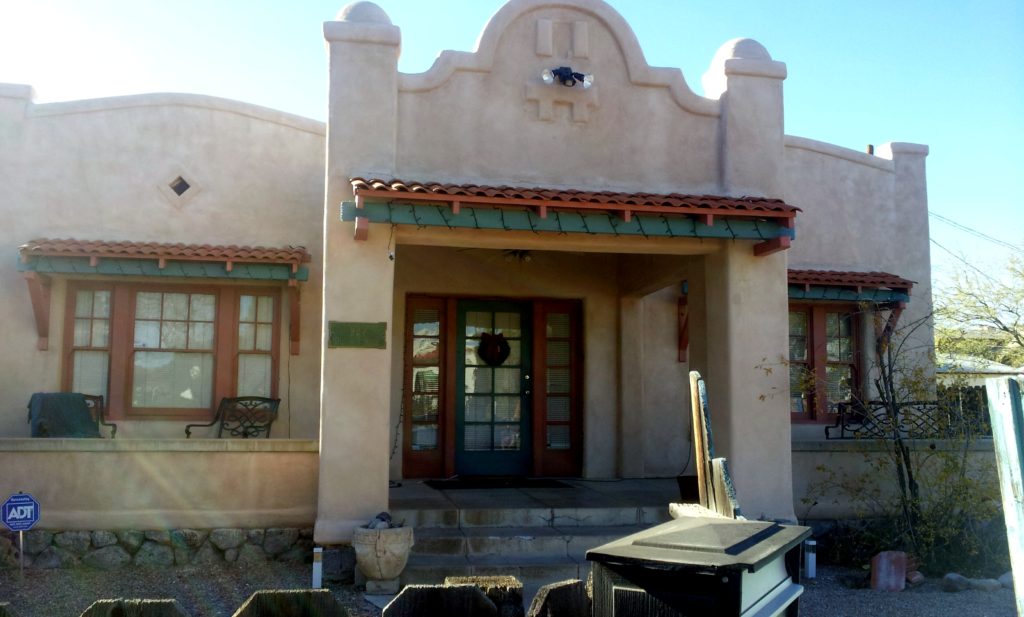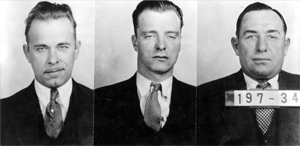Earlier that evening, Dillinger had been taken into custody by three Tucson police officers at the bungalow at 927 North Second Avenue.

In the early morning hours of January 21, a fire broke out in the Hotel Congress. Firemen swept through the building, banging on the doors of the sleeping guests. Oddly, a resident of the top floor seemed more concerned about his luggage than himself, and he put up a fuss when ordered to leave the building. Out on the sidewalk, he persuaded two firemen to re-enter the burning building to retrieve several expensive-looking bags.
Three days later, one of the firemen noticed a strong resemblance between the man who had been very protective of his luggage and a photo in the lineup section of a detective magazine he was reading. The face in the photo belonged to Russell Clark, a member of the John Dillinger gang.
Meanwhile, the same man and two of his friends had attracted the attention of a couple of tourists who had crossed paths with them the previous evening in a nightclub. He was boasting how easy it was to make a living robbing banks.
The tourists went to the police, who began an investigation. It was determined that Harry Pierpont (the man in the middle), “Fat Charlie” Makley (the one on the right) and Russell Clark — all notorious members of the Dillinger gang — had come to town. And police surmised that Dillinger himself was not far behind.
In quick order, Makley was arrested in a downtown radio repair shop. Pierpont, said to be the most dangerous of the gang because he killed for pleasure, was stopped at the intersection of Sixth Avenue and Nineteenth Street for a “routine” check of his automobile papers and arrested.
Clark was the most difficult to arrest. Traced to a rented house on North Second Avenue near the University of Arizona, he put up a vigorous fight that left him with a lacerated scalp. A search of the premises revealed the expensive looking bags firemen had rescued from the Hotel Congress. In them was an assortment of machine guns, pistols, ammunition and bullet-proof vests.
With the members of the gang in custody, the search now focused on the elusive Dillinger. Confident he would eventually show up at the Second Avenue house, the police placed it under surveillance.
Meanwhile, Dillinger had registered under an assumed name at a tourist court on South Sixth Avenue. At 6:30 p.m. on January 25, he came to visit his cohorts. As he made his way up the walk, three police officers sprang into action, and Dillinger was arrested without incident. Caught wholly off guard by the stakeout, his only words were, “Well, I’ll be damned!”
Excitement swept the city and the nation at the news: without firing a shot, the Dillinger gang had been apprehended in a small Southwestern city. The public treated Dillinger more like a celebrity than a notorious outlaw. Fox Movietone News rushed in a camera crew from Hollywood. Some 2,000 people converged on the county jail, hoping for a glimpse of the man. His meals were catered by a nearby restaurant, and he was allowed to have his terrier puppy in jail with him.
Local authorities knew that wherever Dillinger was, trouble usually followed, and they were anxious to get him out of Arizona as quickly as possible. Among several states vying for the right to try Dillinger, Indiana was chosen, at least in part because it was holding a murder warrant for the killing of a man during a bank robbery in East Chicago. Dillinger was extradited on January 31 and delivered to the Lake County jail in Crown Point, Indiana. The jail was dubbed “escape-proof” by Sheriff Lillian Holley, but she soon had to eat her words. On March 3, 1934, he escaped from the jail. Accounts differ as to whether he was armed with a submachine gun or with a piece of wood painted black and carved to look like a gun.
Dillinger went back to robbing banks. In July of that year, he was shot and killed by FBI agents as he tried to escape from a trap they had set outside the Biograph Theater in Chicago.
